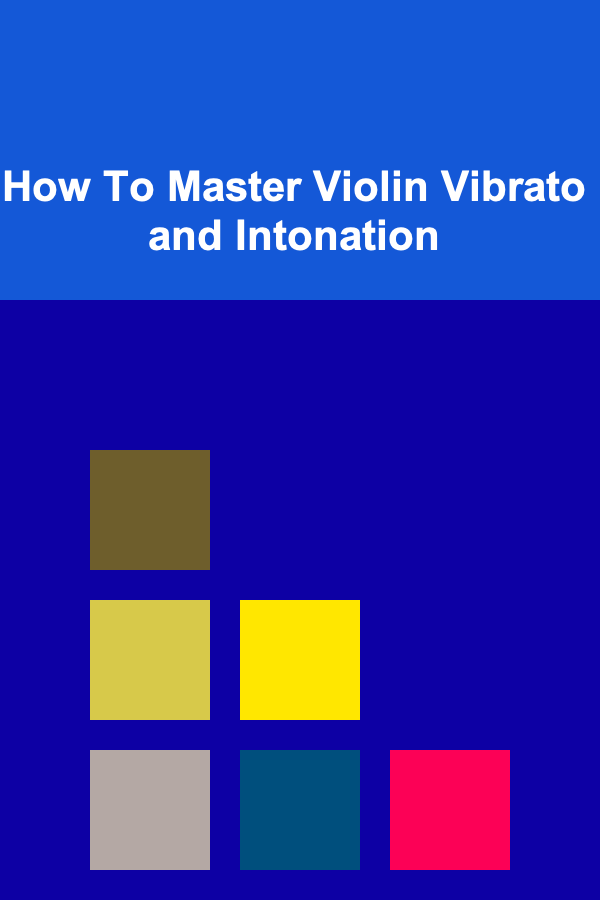
How To Master Violin Vibrato and Intonation
ebook include PDF & Audio bundle (Micro Guide)
$12.99$11.99
Limited Time Offer! Order within the next:

The violin is a deeply expressive instrument that demands a high level of precision and emotional conveyance from its players. Among the many techniques that contribute to a violinist's expressive capabilities, vibrato and intonation are two of the most essential. Mastering both not only elevates a player's musicality but also allows them to communicate with more depth and resonance through the instrument. While achieving mastery in these areas may take time and patience, a thorough understanding of their mechanics, combined with diligent practice, can lead to stunning progress.
In this article, we will explore how to master violin vibrato and intonation. We will begin by discussing the importance of these techniques, their fundamental principles, and effective strategies for refining them. Whether you're a beginner or an intermediate player, this guide will provide you with practical insights to elevate your violin skills to the next level.
Understanding Vibrato and Intonation
Before diving into the specifics of how to master vibrato and intonation, it is crucial to first understand what these terms mean and why they are so important in violin playing.
What is Vibrato?
Vibrato is a technique used to add expression and warmth to a note by oscillating its pitch slightly. This oscillation, typically around a semitone (a half-step), creates a subtle "wobble" effect, which brings life to the note. Vibrato can be used on both long and short notes and is often employed to highlight musical phrases, adding emotional depth.
What is Intonation?
Intonation refers to the accuracy of pitch when playing a note. For string players, intonation is especially crucial because there are no frets on the violin to guide finger placement. Violinists rely on muscle memory, ear training, and visual cues to ensure they play in tune. Perfect intonation is vital for both solo and ensemble performances, as even small deviations in pitch can be noticeable.
The Connection Between Vibrato and Intonation
While vibrato and intonation are separate techniques, they are interconnected. Vibrato can sometimes mask slight pitch inaccuracies by adding a layer of dynamic movement to the sound. However, relying too heavily on vibrato to cover up poor intonation is not ideal. A violinist should strive to achieve both perfect intonation and expressive vibrato in tandem, so that each note resonates both in terms of pitch accuracy and emotional depth.
Part I: Mastering Violin Vibrato
Mastering vibrato involves learning how to produce a controlled oscillation of the pitch, which is accomplished by a combination of arm, hand, and finger movement. Developing this technique requires building muscle memory, flexibility, and control, but once it's achieved, vibrato can dramatically transform the sound of the violin.
Step 1: Understanding the Mechanics of Vibrato
To execute vibrato, a violinist needs to engage several key muscles, particularly in the arm, wrist, and fingers. The basic movement involves a rocking motion from the arm, with the hand and fingers following suit. The movement should feel fluid, without excessive tension in the hand or arm.
- Arm Movement: The primary motion in vibrato comes from the forearm. The forearm rocks back and forth, while the hand remains relaxed, following the movement of the arm.
- Wrist and Finger Engagement: As the forearm moves, the wrist should naturally bend to allow for smooth, controlled oscillation. The fingers should maintain a firm but flexible grip on the violin, allowing the pitch to fluctuate subtly with each oscillation.
- Balance Between Control and Relaxation: While the technique involves physical motion, vibrato should never feel tense. Tension in the arm, hand, or fingers can hinder the natural flow of the vibrato and affect its effectiveness.
Step 2: Developing a Solid Vibrato Technique
Vibrato can take months or even years to master, but the process can be broken down into manageable stages.
- Slow Practice: Start by practicing vibrato on open strings or with simple finger exercises, focusing on a slow and controlled motion. Begin with your arm gently rocking, ensuring that your wrist and hand follow. Focus on creating a consistent motion without jerking or sudden shifts in pitch.
- Building Flexibility: A common problem for many beginners is the lack of flexibility in the arm and wrist, which results in a rigid and strained vibrato. To avoid this, practice keeping the arm relaxed and fluid. Try focusing on how the wrist and fingers feel as they move in a natural, flowing pattern.
- Gradual Speed Increase: Once you feel comfortable with the basic motion and slow vibrato, gradually increase the speed. Aim for a smooth and even oscillation that doesn't feel forced or rushed.
- Vibrato on Different Strings: After mastering vibrato on open strings, practice with different notes on the fingerboard. This will help you develop the ability to produce consistent vibrato across all strings, adjusting the arm and wrist movements to accommodate the varying string tensions.
Step 3: Refining Vibrato for Expression
Once the basic technique is in place, the next step is to refine your vibrato for expressive purposes.
- Varying Speed and Width: A skilled violinist can adjust the speed and width of their vibrato to create different emotional effects. For example, a slower and wider vibrato often conveys a more sorrowful or dramatic mood, while a faster and narrower vibrato can evoke excitement or intensity.
- Applying Vibrato Musically: Vibrato should not be applied to every note. The key is to use vibrato selectively to enhance musical phrases and highlight emotional moments. Overuse of vibrato can lead to a loss of musical clarity. Practice varying your use of vibrato according to the musical style and emotional content of the piece.
- Coordination with Bowing: Vibrato should work in harmony with your bowing technique. The vibrato's speed and intensity should complement the bow stroke, creating a seamless sound that conveys both pitch and emotion.
Part II: Mastering Violin Intonation
Intonation is one of the most challenging aspects of violin playing, as it requires precise finger placement without visual aids like frets. Unlike other instruments, the violin's fingerboard offers no physical markers for where each note should be placed. Instead, violinists must rely on their ears and muscle memory to ensure that they play in tune.
Step 1: Developing a Strong Ear
The foundation of good intonation lies in developing an excellent musical ear. A violinist must train themselves to hear even the smallest discrepancies in pitch. One of the most effective ways to strengthen your ear is through regular practice with a tuner and by tuning your violin accurately.
- Use of a Tuner: A digital tuner is an invaluable tool when working on intonation. Use the tuner to check your pitch accuracy frequently, but also learn to hear when your pitch is close to being in tune. This will allow you to play more confidently without constantly relying on external devices.
- Listening to Professional Recordings: Listen to recordings of skilled violinists and pay close attention to their intonation. Try to emulate the precision and consistency of their pitch. Doing this will help you internalize the correct intonation and bring it into your own playing.
Step 2: Finger Placement and Muscle Memory
Achieving correct intonation requires precise finger placement, which in turn relies on muscle memory. Without the visual reference of a fretboard, the violinist must train their hand to place their fingers in exactly the right spots on the fingerboard.
- Open String Tuning: Start by tuning the open strings of the violin. Make sure the violin is in perfect tune before playing anything else. This is the foundation for accurate intonation, as you will rely on the pitch of the open strings to help you tune your fingers.
- Practice with Drones: A drone is a continuous note (often played by a tuner or another instrument) that serves as a reference pitch. Playing along with a drone helps you train your ear to hear and match pitches more accurately. Practice playing scales, arpeggios, and exercises with a drone in the background.
- Use of Finger Markers: Some violinists use finger markers or stickers on the fingerboard to provide a visual reference for finger placement. These markers can help beginners develop muscle memory and gain confidence in their intonation.
Step 3: Strengthening Intonation Through Scales and Exercises
Scales are one of the most effective ways to practice intonation. By playing scales regularly, you build muscle memory for finger placements on the violin, which will directly translate into more accurate intonation.
- Practice Slow Scales: Begin by practicing scales slowly and deliberately. This will allow you to pay close attention to each note and ensure it is in tune. Focus on the sound of each note, using the open strings and your ear to gauge its accuracy.
- Play in Different Keys: Once you've become comfortable with basic scales, practice in different keys to challenge yourself. The finger placements will vary slightly depending on the key, helping you develop flexibility in your intonation.
- Practice Double Stops: Double stops, or playing two notes simultaneously, are another excellent way to practice intonation. Playing two notes helps you develop your ear for interval tuning and ensures that both notes are in tune relative to each other.
Step 4: Correcting Intonation Issues
Even after years of practice, intonation issues can still arise. It is important to identify and address common intonation problems early.
- Flat or Sharp Notes: If your notes tend to be flat (too low) or sharp (too high), you may need to adjust your finger placement or bowing technique. Check your finger placement by comparing the sound of the note to the open string or a tuner.
- Adjusting Bowing: Sometimes, intonation issues are not due to finger placement but rather bowing. Uneven bow strokes or poor bow pressure can cause pitch inaccuracies. Focus on using even, controlled bow strokes for more consistent pitch.
- Feedback from a Teacher or Mentor: If you're still struggling with intonation, seek feedback from an experienced teacher or mentor. They can help pinpoint areas for improvement and provide valuable guidance.
Conclusion
Mastering violin vibrato and intonation is a lifelong pursuit that requires dedication, patience, and consistent practice. Both techniques play a crucial role in expressing musicality and ensuring pitch accuracy. By understanding the mechanics of vibrato, developing a strong ear for intonation, and consistently refining your technique, you can significantly improve your violin playing. Whether you're an aspiring soloist or a dedicated ensemble player, the mastery of these fundamental techniques will elevate your musicianship and bring your violin playing to new heights. Keep practicing, stay committed, and enjoy the musical journey ahead!

How to Personalize Your Home Office While Staying Organized
Read More
How to Score Big Savings with Smart Bargain Hunting
Read More
How to Use Podcasting Equipment to Make Money
Read More
Navigating the Boardroom: Strategies and Insights for Executive Assistants
Read More
The Importance of Quantifying Achievements in Your Resume
Read More
Understanding the Global Adoption of EVs: A Multifaceted Perspective
Read MoreOther Products

How to Personalize Your Home Office While Staying Organized
Read More
How to Score Big Savings with Smart Bargain Hunting
Read More
How to Use Podcasting Equipment to Make Money
Read More
Navigating the Boardroom: Strategies and Insights for Executive Assistants
Read More
The Importance of Quantifying Achievements in Your Resume
Read More